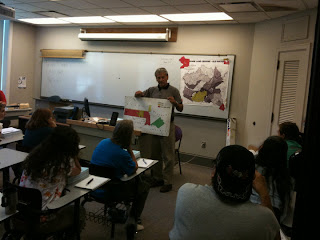I spent Sunday driving around the Sallisaw area and visited 8 cemeteries. (Those photos are on a different blog -
http://wheremypeoplerest.blogspot.com/). I arrived in Tahlequah in time for the 5:30 pm hogfry. There was a huge tent out in front of the campus welcoming us. Eight of us are from the Cherokee Satellite Communities: Wendi from Riverside, Missy from Orange, Daniel and Joyce from Central Florida (although Joyce had just recently moved to Oklahoma), Jessie from the Bay Area Group but now attending Haskell University in Kansas, Heidi from Bakersfield, and Scott and I from the Silicon Valley Group. All our other classmates are from the local area. It is a good mix of people.
PHOTOS OF THE CAMPUS
MY DORM BUILDING IN SEMINARY SUITES
MY ROOM
AT THE ENTRANCE TO THE UNIVERSITY
SEQUOYAH AND ME
JOHN VAUGHN LIBRARY
I spent a lot of time in the library, especially in the Special Collections section, which has many Cherokee historical and genealogical resources.
SEMINARY HALL WITH STATUE OF SEQUOYAH
Seminary Hall is the oldest building on campus. Our class is held in Room 218 and we have spent a lot of time in this room. We attend class from 8am to 5:30pm on Mondays through Thursdays; on Fridays we take field trips. This building was the original site of the Female Seminary. The Cherokees started the first free public co-educational schools in the U.S. They believed strongly in the education of both boys and girls.
THE ORIGINAL PILLARS
These two pillars are from the original seminary buildings parts of which were destroyed by fire. One pillar is from the Male Seminary and the other is from the Female Seminary.
STREAM RUNNING THROUGH CAMPUS
Principal Chief, Chad Smith, came to our class one morning and lectured for about an hour on the Cherokee Land Allotments. It's his belief that this period in history did more harm to the Cherokee people than the Trail of Tears. He was a very engaging presenter and spent a lot of time after answering our questions.
THE BACKSIDE OF THE SIGN AT THE ENTRANCE
This fountain is a constant reminder of why the Cherokees are so invested, both financially and emotionally, in education.



